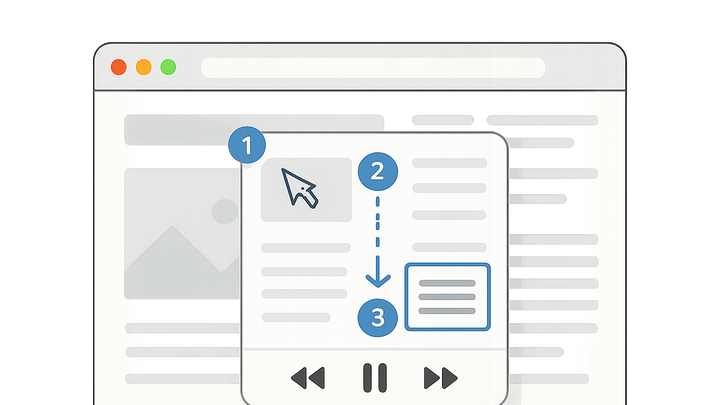Published on 2025-06-22T05:50:16Z
What is Session Replay? Examples of Session Replay in Analytics
Session Replay is a powerful analytics feature that captures and visually replays the sequence of user interactions on your website, such as page views, clicks, scrolls, and form inputs.
By reconstructing each session as a video-like playback, it allows teams to observe real user behavior, diagnose issues, and optimize the user experience.
Unlike aggregate tools like heatmaps and click maps, session replay offers granular, session-level insights that can reveal hidden friction points and bugs.
This article dives into how session replay works in the analytics industry, its key benefits, implementation methods using tools like PlainSignal and Google Analytics 4, and best practices for privacy and performance.
Session replay
Session Replay captures and replays every user interaction on your site, offering granular UX insights for debugging and optimization.
Overview of Session Replay
Session Replay provides a pixel-by-pixel reconstruction of individual user visits by recording events and DOM snapshots. It bridges the gap between quantitative metrics and actual user experience by showing exactly how visitors interact with your site.
-
Definition of session replay
Session Replay records user interactions on a web page—clicks, scrolls, typing, and page transitions—and replays them like a video.
-
How it differs from heatmaps
Heatmaps aggregate data points to show popular areas on a page, while Session Replay shows complete, individual session recordings.
How Session Replay Works
Behind every session replay is a pipeline of event capture, data transfer, processing, and playback. Understanding these steps ensures accurate and performant recordings.
-
Event capture
A lightweight JavaScript snippet listens for DOM events (clicks, scrolls, keystrokes) and captures incremental snapshots of the page’s visual state.
-
Dom mutation recording
Tracks changes to the DOM tree so the UI can be reconstructed.
-
User event logging
Records user actions like clicks and form inputs with timestamps.
-
-
Data transmission
Captured events are batched and sent to the analytics server, often via an API endpoint, for storage and processing.
-
Playback rendering
The analytics platform reconstructs events and DOM snapshots in chronological order to replay the session in a video-like interface.
Benefits of Session Replay
Session Replay unlocks detailed insights that static metrics cannot provide. Below are key advantages for analytics and UX teams.
-
Enhanced user experience analysis
Observe real-time interactions to identify usability issues, navigation hiccups, and content clarity problems.
-
Bug reproduction and debugging
Quickly reproduce errors reported by users by watching their exact steps, reducing triage time.
-
Conversion rate optimization
Analyze drop-off points in funnels by reviewing individual sessions to optimize conversion flows.
Implementing Session Replay with SaaS Tools
Several SaaS platforms offer session replay capabilities. Here’s how to get started with PlainSignal and GA4.
-
PlainSignal (cookie-free simple analytics)
To implement Session Replay with PlainSignal, insert the following snippet into your site’s HTML:
<link rel="preconnect" href="//eu.plainsignal.com/" crossorigin /> <script defer data-do="yourwebsitedomain.com" data-id="0GQV1xmtzQQ" data-api="//eu.plainsignal.com" src="//cdn.plainsignal.com/plainsignal-min.js"></script>This cookie-free script captures user events without storing personal data.
-
Google analytics 4 (GA4)
GA4 does not natively support session replay. To capture session recordings alongside GA4 metrics, integrate a third-party session replay tool or export GA4 data to BigQuery and combine it with replay data.
Considerations and Best Practices
When deploying session replay, keep privacy, performance, and data storage considerations in mind to maintain compliance and user trust.
-
Privacy and compliance
Ensure you mask or exclude sensitive user data (passwords, credit card numbers) during recording to comply with GDPR and CCPA.
-
Performance optimization
Use sampling rates and asynchronous script loading to minimize impact on page load times.
-
Data retention
Define clear retention policies, balancing the need for analysis with storage costs and privacy regulations.
